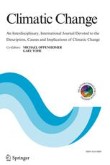
Abstract
Cities in the USA and around the world have begun to take an active role in responding to climate change. A central requirement for effective urban climate strategies is the capacity to understand and measure how the climate is changing, the physical, environmental, and social impacts of the changes, and whether adaptation and resiliency policies and programs put in place in response are working. The objective of this paper is to review and assess how urban climate change and resiliency efforts can be measured and to define what might serve as meaningful indicator and monitoring protocols. The New York City Panel on Climate Change (NPCC) is used as a case study along with a reviews of the emerging literature of urban climate change indicators to analyze the requirements and processes needed for a successful urban climate resiliency indicator and monitoring (I and M) system. In the paper, the basic requirements of a proposed Urban Climate Resilience Indicators and Monitoring System are presented. A specific illustration of an I and M system for tracking the urban heat island highlights challenges as well as potential solutions embedded within such systems. Discussions how these protocols can be translated to other locales and settings, as well as the relationship to the US National Climate Assessment indicator process, are presented.



Δεν υπάρχουν σχόλια:
Δημοσίευση σχολίου
Σημείωση: Μόνο ένα μέλος αυτού του ιστολογίου μπορεί να αναρτήσει σχόλιο.